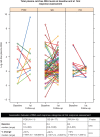A prospective study of total plasma cell-free DNA as a predictive biomarker for response to systemic therapy in patients with advanced non-small-cell lung cancers
- PMID: 26487589
- PMCID: PMC4684155
- DOI: 10.1093/annonc/mdv498
A prospective study of total plasma cell-free DNA as a predictive biomarker for response to systemic therapy in patients with advanced non-small-cell lung cancers
Abstract
Background: While previous studies have reported on the prognostic value of total plasma cell-free deoxyribonucleic acid (cfDNA) in lung cancers, few have prospectively evaluated its predictive value for systemic therapy response.
Patients and methods: We conducted a prospective study to evaluate the association between changes in total cfDNA and radiologic response to systemic therapy in patients with stage IIIB/IV non-small-cell lung cancers (NSCLCs). Paired blood collections for cfDNA and computed tomography (CT) assessments by RECIST v1.0 were performed at baseline and 6-12 weeks after therapy initiation. Total cfDNA levels were measured in plasma using quantitative real-time polymerase chain reaction. Associations between changes in cfDNA and radiologic response, progression-free survival (PFS), and overall survival (OS) were measured using Kruskal-Wallis and Kaplan-Meier estimates.
Results: A total of 103 patients completed paired cfDNA and CT response assessments. Systemic therapy administered included cytotoxic chemotherapy in 57% (59/103), molecularly targeted therapy in 17% (17/103), and combination therapy in 26% (27/103). Median change in cfDNA from baseline to response assessment did not significantly differ by radiologic response categories of progression of disease, stable disease and partial response (P = 0.10). However, using radiologic response as continuous variable, there was a weak positive correlation between change in radiologic response and change in cfDNA (Spearman's correlation coefficient 0.21, P = 0.03). Baseline cfDNA levels were not associated with PFS [hazard ratio (HR) = 1.06, 95% confidence interval (CI) 0.93-1.20, P = 0.41] or OS (HR = 1.04, 95% CI 0.93-1.17, P = 0.51), neither were changes in cfDNA.
Conclusions: In this large prospective study, changes in total cfDNA over time did not significantly predict radiologic response from systemic therapy in patients with advanced NSCLC. Pretreatment levels of total cfDNA were not prognostic of survival. Total cfDNA level is not a highly specific predictive biomarker and future investigations in cfDNA should focus on tumor-specific genomic alterations using expanded capabilities of next-generation sequencing.
Keywords: biomarker; chemotherapy; non-small-cell lung cancer; plasma cell-free DNA.
© The Author 2015. Published by Oxford University Press on behalf of the European Society for Medical Oncology. All rights reserved. For permissions, please email: journals.permissions@oup.com.
Figures


References
-
- Leon SA, Shapiro B, Sklaroff DM, Yaros MJ. Free DNA in the serum of cancer patients and the effect of therapy. Cancer Res 1977; 37: 646–650. - PubMed
-
- Jahr S, Hentze H, Englisch S et al. . DNA fragments in the blood plasma of cancer patients: quantitations and evidence for their origin from apoptotic and necrotic cells. Cancer Res 2001; 61: 1659–1665. - PubMed
-
- Stroun M, Lyautey J, Lederrey C et al. . About the possible origin and mechanism of circulating DNA apoptosis and active DNA release. Clin Chim Acta 2001; 313: 139–142. - PubMed
-
- Ignatiadis M, Dawson SJ. Circulating tumor cells and circulating tumor DNA for precision medicine: dream or reality? Ann Oncol 2014; 25: 2304–2313. - PubMed
Publication types
MeSH terms
Substances
Grants and funding
LinkOut - more resources
Full Text Sources
Other Literature Sources
Medical

